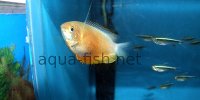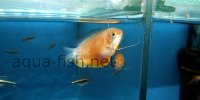The Dwarf Gourami (Colisa lalia) Care, Breeding and Pictures
Quick links - Answers
Brief Description
Colisa lalia is a peaceful freshwater fish, also known as the “Dwarf Gourami”. Gourami is the name used for a big variety of perciform fish coming from Asia, especially India and Pakistan characterized by flat body and two elongated rays of pelvic fins used as sense of touch.
Introduction
Since they reach only 2 inches, they can be housed in small tanks and are a good fish for beginners because of their low aggressiveness, easy care and nice look.
Males can be easily distinguished from females for their colours. The dwarf gourami male is a bit bigger than the female and has turquoise and orange-red iridescent vertical bands on the entire body and on fins; you can find also colour mutations with total orange-red body and turquoise dorsal fin, or total turquoise body with just some red at the edges of the fins. The dwarf gourami female is totally silver with pale turquoise vertical stripes.
Colisa lalia can live in small groups or couples, both in dedicated or community aquariums. Males have some territorial habits especially during the breeding period, so it’s better to house just one male in small tanks. Females can live together without any problems.
Aquarium
Colisa lalia are anabantidae, they can breath directly from air thanks to their labyrinth organ. Anabantidae have developed that organ because they live usually in low oxygenated water in the wild; even if aquarium water is cleaner and more oxygenated, they keep on breathing directly from air because their gills don’t work well. For this reason, and because they’re good jumpers, a closed on top aquarium is recommended.
If you want to house just a male with one or two females you can use a 10 gallons tank. Water temperature can fluctuate around 77°-80° F (25°-27° C), they don’t request particular chemical values, a 6 -7 PH and medium hardness water are perfect.
If possible, it’s better to put the aquarium to a quiet place, because gourami get easily stressed by various noises.
The aquarium design is a personal choice, anyway it’s important to respect some parameters:
- high number of plants. Colisa lalia live in the biotopes with plenty of plants, it’s important to create the nest and to make them feel safe, since especially females are often frightened.
- choose the decorations carefully. High edged rocks can damage the touch rays on the belly. Dwarf gourami are also very curious and can get caught in decorations with small openings and holes.
Moreover, a dark gravel on the ground can make colisa colours brighter, while female colours would almost disappear on a light or white gravel ground.
If you want to house more males choose a bigger aquarium, populated with other fish that can distract them. In nature, they live with other gourami, like colisa chuna and some trichogaster: you can consider to create an aquarium dedicated to asian fish. Avoid adding fish that usually bite long fins, because they could break the touch rays of colisa lalia.
Feeding
Colisa lalia are carnivorous fish and usually eat dry food without problems. Anyway they easily suffer of constipation so it is important to feed fish with good foods in the right way. Feed colisa lalia once a day, with a pause (no food) day once a week. Prefer quiet moments of the day, when there aren’t high noises around. In case of shy fish feed them some minutes before switching off the lights. Avoid flakes and other low quality dry food, they have the tendency to swell fish belly.
The best to offer is jelly conserved, frozen and live foods. You can choose among various foods like chironomus, daphnie, brine shrimps, earth worms, meal worms, fry and more.
Breeding
Breeding colisa lalia is quite easy and similar to the betta splendens one, but it is important to follow some rules:
- Set up a dedicated tank in case you don’t have, with the male and one or two females. Dwarf gourami creates bubble nests so they need to be separate from the community aquarium crowd that could break the nest. Use a 5 gallons or bigger tank, without gravel or sand on the ground. Put a good number of plants, some of them floating, some other can be fixed in one or more small pots. The aquarium must be closed and must have a good lightening system, the death of plants during breeding can pollute the water and kill the fry. The breeding tank needs also a heater and a filter, put a small net or sponge in front of the water way in, to avoid fry to end inside the filter.
- Choose young and healthy fish. Within the colisa lalia species, it is hard to see the ovipositor and sometimes a fat belly female can be mistaken for a female ready to spawn eggs; that’s why a good feeding is important.
Breeding can be described in these steps:
- raise the temperature to 80°F (27°C) and lower the water level.
- the male builds a bubble nest with the help of plants. The nest is usually built among floating plants like Pistia stratiotes, and among bubbles there are often small parts of other plants, broken and chewed by the male. From now it is better to switch off the filter.
- after some days of rich feeding even twice a day with frozen or live food, female could be ready for spawning. During courtship, the male swims around the female and try to take her under the nest. In case she accepts the courtship they start swimming in circles, and when she’s ready to spawn she touches the body and fins of the male with the mouth.
- Colisa usually embrace various times, every time after the egg spawning the male stops to collect the fallen eggs and put them in the nest.
- if there is more than the female present in the aquarium, the male will spawn with all. The spawning usually takes some hours and the number of eggs reach 500.
- after spawning the male covers the egg with a layer of bubbles, to avoid them falling down. At this point all the females should be removed because the male could become aggressive to protect the nest.
- after two days usually fry come out the egg, and after three more days they will be able to swim, at this time the male should be removed, because could eat the fry. Now that the nest is useless the filter can switched on again.
- for the first days they should be feed with infusoria and other small foods, then you can give them small live brine shrimps. In shops you can find also dry food for fry, anyway often fry eat only live food.
Thanks to Jose J. for allowing us to use his picture. Also thanks to Cyberraga!
Copyright note: This article is originally written by Michela Ferretti. Aqua-fish.net owns the full copyright of this article.
Questions and answers
You're welcome to post own unique questions that haven't been answered in the article yet. On March 24th 2011 we added the following question here due to merging aqua-fish.net/answers with related pages in order to serve all information from one place.
What fish can I keep with a dwarf gourami?
Answer: These fish should not be kept with aggressive tank mates. Some peaceful companions that may work are: Corydoras catfish, bristle nose catfish, tetras, most livebearers, and plecos.




